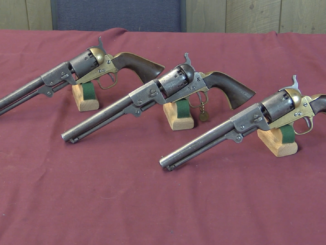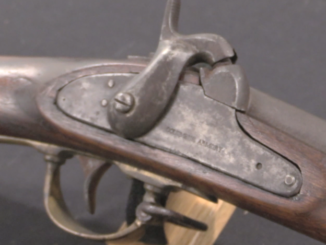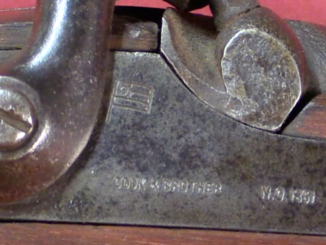James Kerr formed the London Armoury Company in 1856, manufacturing Adams patent revolvers (Adams was one of the founding investors) and 1853 pattern Enfield rifles. The rifles were the better business and the company rather quickly decided to focus on them, which led Adams to leave with his patents. In order to keep a revolver in the LAC’s catalog, Kerr patented his own design, which proved to be a quite effective handgun.
When the US Civil War broke out, both the Union and the CSA sent procurement agents to Europe to purchase foreign arms, and the Confederate’s Captain Caleb Huse struck a substantial deal with the London Armoury Company. The Confederacy would ultimately purchase more than 70,000 Enfield pattern rifles from LAC, as well as Kerr’s patent sharpshooting rifles and 7,000-9,000 Kerr revolvers – the vast majority of LAC’s production during the war. So much of their production, that the LAC would actually fail and dissolver in 1866 when their best customer ceased to exist.
The revolver design was made in single and double action versions and in both .36 and .44 calibers, although the CSA purchased guns were all single action .44s. The action is basically a simple rifle style lockplate mounted on the grip and frame, isolated form the soot and fouling of the black powder very well. The cylinder is easily removed via an axis pin entering the rear of the frame, and the guns could be easily serviced by any competent gunsmith without need for any special knowledge or parts.
The two we have in today’s video are actually consecutive serial numbers (10,110 and 10,111) right at the very end of the Confederate acquisition period.




I am always intrigued as to the seller provenance when Ian has a set of linked guns from James G. Julia or Rock Island Action. Clearly the collection of a serious collector of Confederate guns is being sold here. The fact that no serious collector of anything gives anything up. unless it is prised from his cold dead hands, strongly suggests that the last round of the collector’s life had been fired over his resting place.
There was a similar collection of Lee Enfields Ian covered recently.
Part of me regrets the fact that complete collections are having to be broken up.
On the other had: the fact that Ian has used this site to record guns in a former collection does preserve the collection in a more substantive way than when they were owned by just one person.
Ian mentioned Balázs Németh’s video, you should watch it: https://www.youtube.com/watch?v=l4Cgt2ah41A. 🙂
Nice !
Their channel seems to have been updated !
I wish his English was just a little better. He mentions loading 21 grains of powder…and some sort of filler that I could not make out at ALL.
Also good to get a sense of the sheer quantity of smoke generated by black powder firearms. I don’t know if his powder is cleaner than what would have been in use in 1861-5.
I don’t know if it will answer you, but from what I read on forums, using semolina between blackpowder and bullet is used to get better results (compression & combustion)
I just listen one of his video :
He uses Swiss-made black powder.
In Europe, this powder is seen as high quality black powder : burns well, low fouling.
Does anyone know if any replicas of Kerr, Adams or any Lefaucheux have been produced?
“Lefaucheux”
I don’t about replica of that revolver, but I want to note that after extinction of pinfire system from normal-size fire-arms, it was still deployed in some miniatures, see 2nd image from top here: https://minifirearms.com/2-mm-pinfire-guns/
I was assuming about Lefaucheux triple action system and design overall rather than just pinfire system, but yes, pinfire is still popular for this kind of “toy”.
“Lefaucheux triple action system”
What is that? (I have rather small knowledge about French 1850s revolvers)
According to littlegun.info: “It is a model called to ‘Triple Action’ according to patent 55784 of September 27, 1862, calibres 12 mm pinfire.” [http://www.littlegun.info/arme%20francaise/artisans%20k%20l/a%20lefaucheux%20triple%20action%20gb.htm] I think it is simply a DA/SA revolver.
By the way, I think the term of “triple action” is somewhat “overused”:
– in context of revolvers I have found it means DA/SA revolver (the three action: 1. hammer cocking with trigger pull, 2. rotating cylinder, 3. release the hammer);
– in context of Nagant M1895 it means (double action trigger system?) with gas-seal system;
– in context of Hopkins & Allen revolvers it means some kind of hammer block safety mechanism;
– in context of Daewoo K5/DP51 it is an unusual “fast action” (most recently known as Double Action Plus+) trigger mechanism which allows the hammer to be decocked while still keeping the mainspring compressed. It allows the trigger travel of the double-action mode and the trigger weight of single-action mode.
Probably not, at least not commercially. Perhaps if the role of the Kerr was better known among US civil war aficionados, there could be a big enough market for a commercial repro. The action is simple enough that it should not be hugely expensive to make.
The meaning of the mark J S over an Anchor has been debated for years in several publications. The most recent book that I have on Confederate Weapons discusses this question at length and reviews claims. See page 112, 113, of Pritchard, Russ A. Jr., and C.A. Huey, The English Connection: Arms, Material and Support Furnished to the Confederate States of America by Great Britain, Gettysburg, PA: Thomas Publications, 2014, 608 pp
Pritchard thinks the best suggestion at this time is that it is the mark of John Southgate, contract viewer for the London Armoury company. Others have suggested it might be John Smiles, also a viewer for LAC. Or maybe John Sinclair, a partner in Sinclair, Hamilton, & Co. importers of weapons for the Confederacy. Then there is John Slidell, a Confederate Commissioner to Europe, but maybe James Seddon, a Confederate Secretary of War. But wait . . .there is more. Perhaps this is a mark used by a team of viewers, since the mark is found on a variety of arms for the Confederacy.
There is an Anchor over S mark on the comb of the stock on some Pattern 1853 muskets–but even less is known about this mark. Pritchard’s book should be in the hands of every collector of weapons of the Confederacy.
Come, brothers, rally for the right!
The bravest of the brave
Sends forth his ringing battle-cray
Beside the Atlantic wave.
She leads the way in honor’s path:
Come, brothers, near and far,
Come, rally round the Bonnie Blue Flag
That bears a single star!
Hurrah! hurrah! for Southern rights
Hurrah!
Hurrah for the Bonnie Blue Flag
That bears a single star!
II
We’ve borne the Yankee trickery,
The Yankee gibe and sneer,
Till Northern insolence and pride
Know neither shame nor fear;
But ready now with shot and steel
Their brazen front to mar,
We holst aloft the Bonnie Blue Flag
That bears a single star.
III
Now Georgia marches to the front,
And close beside her come
Her sisters of the Mexique sea,
With pealing trump and drum;
Till answering back from hill and glen
The rallying cry afar,
A nation holsts the Bonnie Blue Flag
That bears a single star.
IV
By every stone in Charleston Bay,
By each beleaguered town,
We swear to rest not night nor day,
But hunt the tyrants down;
Till bathed in valor’s holy blood
The gazing world afar
Shall greet with shouts the Bonnie Blue Flag
That bears a single star.
Hail TRUMP!
Hail OUR PEOPLE!
Hail VICTORY!
Stop making us look bad.
Heil Irony.
The Spanish Navy adopted the Kerr revolver in 1862 and begun to manufacture them in ‘Real Fábrica de Placencia’ (Placencia Armory). The Army used Lefaucheux revolver but navy appreciated the simplicity of Kerr lock-work that can be repaired in distant naval stations. In 1864 several defects were corrected, The new model 1864 was made by two private firms, Orbea Hermanos and Fábrica de Durango.
Curiously these were converted to center-fire from 1870 and served in the Navy in two variants: Mod. 1870 and Mod. 1872. Some were still in service in the Spanish-American War, along the more modern Orbea Mod. 1885 (copy of S&W no. 3 DA).
This is an old post, but better later than never: you might also interested in this article:
Valmor J. Forgett: Why Kerrs?
https://americansocietyofarmscollectors.org/wp-content/uploads/2019/06/2008-B97-Why-Kerrs.pdf